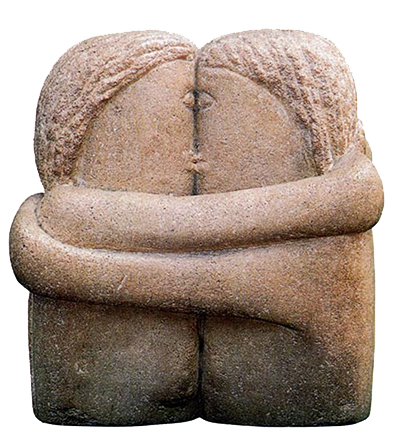The Kiss was one of Brancusi's greatest sculptures, another of his non-literal and proto-cubist representations. It was exhibited in the Armory Show in 1913 and published in the Chicago Tribune in March of the same year. The sculpture was one of six creations that Brancusi constructed between 1907 and 1908.
Versions
There were a number of versions of The Kiss that Brancusi sculpted, each of them simplifying the concept of sparse objects and geometry in his forms further. These simplifications made his creations continue leaning towards abstraction. This is because Brancusi's abstract sculpture style largely emphasised on simple geometrical lines that created an element of balance in his forms with representational art and symbolic allusions. The original sculpture is in Muzeul de Arta in Romania. Another version of this sculpture is the Adornment of a tomb present at in Paris at the Montparnasse cemetery and another is present at the Philadelphia Museum of Art.
Material and Content
The Kiss sculpture was carved out of limestone with the core function of expressing the subject of the sculpture in the purest form possible. The outcome included intertwined figures that are seemingly interlocked to each other, with a woman on the right looking slightly thinner with smaller eyes. There is a deliberate bulge on one of the subjects to suggest breasts. A closer look and you will notice that the two eyes become one but the limestone's structure interestingly stays true. This brings out the effect of leaving the sculpture’s surface essentially archaic and raw and at the same time bringing back the feeling of the return to the primitive forms of the baroque and renaissance era.
Context, Techniques and Approaches
Brancusi was able to depict a couple kissing, right from their torsos up. The depiction brings out a vivid feeling of love and affection with the evident loving embrace and wrapped arms around each subject. It is interesting to note that the two subjects are simply but barely differentiated to draw the attention of the viewer by the unity of the two forms. He made use of rough stone as opposed to the conventional marble in order to give the art piece an archaic feel but still oozing out a modern look, all thanks to his intricate use of abstractionism. This is in direct contrast with the conventional style that was prevailing at the time, especially as represented by his greatest influences, Auguste Rodin.
Brancusi's The Kiss was an obvious inspiration from Auguste Rodin's The Kiss of 1882 but it marked a significant point in time representing the departure of the artist's style from Auguste's emotive realism. The shift was more towards the creation of simplified forms while maintaining his interest in contrasting features, which was later seen in many of his constructions. Brancusi's style made critics and art lovers focus more on the material used rather than the two lovers kissing. This sparked a conversation among viewers about a block of marble and the underlying meaning of the two forms that were joined together suggesting that there was more to the creation than what met the eye and left to viewers to mull over that hint.
Influences and Inspirations
The direct use of carving as a technique in The Kiss increasingly grew popular during that time causing more artists to develop an interest in primitive forms. May artists at the time emulated his artistic style and it can be noted in some few modern era sculptures too. Some of the greatest artists that Constantin Brancusi inspired were the likes of Isamu Noguchi and Donald Judd, including friends like Amedeo Modigliani and art movements like Minimalism and Art Deco. However, he did not just become great because he was skilled but also because he drew inspiration from great names in the industry like Henri Rousseau and Edward Steichen.




